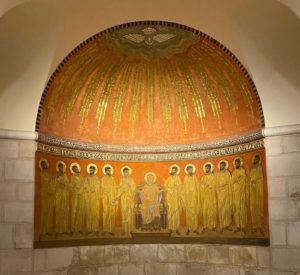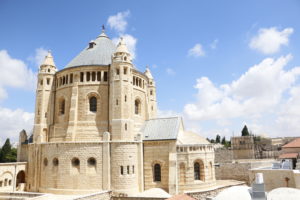The name Zion dates back to the times of David. The city of David was called Zion for its fortress, referenced in the second book of Samuel: “David nevertheless captured the fortress of Zion, which is the City of David.” (2 Samuel 5:7, USCCB). This name later referred to the temple and, by extension, to the entire city of Jerusalem. In medieval times, it was mainly used to designate the hill located to the southwest.
The expression “daughter of Zion” is found in various books of the Old Testament, including:
Micah 4:10-13 “Writhe, go into labor, O daughter Zion, like a woman giving birth; For now you shall leave the city and camp in the fields; To Babylon you shall go, there you shall be rescued. There the LORD shall redeem you from the hand of your enemies. And now many nations are gathered against you! They say, ‘Let her be profaned, let our eyes see Zion’s downfall!’ But they do not know the thoughts of the LORD, nor understand his plan: He has gathered them like sheaves to the threshing floor. Arise and thresh, O daughter Zion; your horn I will make iron And your hoofs I will make bronze, that you may crush many peoples; You shall devote their spoils to the LORD, their riches to the Lord of the whole earth.”
Zephaniah 3:14 “Shout for joy, daughter Zion! Sing joyfully, Israel! Be glad and exult with all your heart, daughter Jerusalem!” To denominate a city as a daughter is a sign of predilection and a way to highlight that it belongs to Yahweh. It is personalized, treated as if it were a person. Thus, the primary meaning of Daughter of Zion was for the entire city of Jerusalem.

Dormition Abbey, Jerusalén
In the time of Jesus Christ, the current Mount Zion was already inside the walls, and nowadays pilgrims can find the following biblical sites on Mount Zion: the Cenacle, the Tomb of David, the Basilica of the Dormition, St. Peter in Gallicantu, and also the supposed palace of Caiaphas where Peter denied Jesus, which would have been where the current Armenian cemetery is near the Cenacle.
If we observe closely, we will realize that Mount Zion is very much associated with Mary. The Virgin Mary would have been present in the Cenacle at the Last Supper, preparing food, and on the day of Pentecost as the Mother of the Apostles. According to the visions of Blessed Emmerich, she visited the Cenacle frequently during the approximately fifteen years she spent on earth without her son, although it might have been thirteen or fourteen, similar to the years she spent on earth before discovering her vocation to marriage with Joseph. Mary frequently visited the place where the Church was established, which was the Cenacle. A very early tradition tells us that, during this time without her son, the Virgin Mary lived in a house at the location now occupied by the Basilica of the Dormition, which is very close to the Cenacle. This tradition is supported by the fact that in the fifth century, the church “Hagia Maria Sion” was built on the same spot. Finally, it was in her house where she fell asleep in the hands of the Holy Spirit.

Dormition Abbey, Jerusalén
Also, in the Second Vatican Council, the figure of Mary as the Daughter of Zion is exalted, thus linking, as a Woman, to the Jewish tradition. “She stands out among the poor and humble of the Lord, who confidently hope for and receive salvation from Him. With her the exalted Daughter of Sion, and after a long expectation of the promise, the times are fulfilled and the new Economy established, when the Son of God took a human nature from her, that He might in the mysteries of His flesh free man from sin.” (LG 55. II. he Role of the Blessed Mother in the Economy of Salvation).
In this case, it is the person of Mary which elevates Mount Zion to be the most relevant mountain because she is in it. Now the Daughter of Zion will rejoice in God her Savior and will be the Mother of all nations.
By Domingo Aguilera Pascual
